Early gray hair is an aesthetic phenomenon when gray hair appears at a young age: up to 25 years in Caucasians, and up to 30 years in people of the Negroid race. By about 40 years of age, hair is almost completely bleached.
Gray hair at an early age, as a rule, is not associated with general aging of the body and is a consequence of unfavorable internal and external factors that disrupt the functioning of melanocyte cells.
Not everyone delves into the root causes of early gray hair, regularly dyes their hair and forgets about the problem, while a symptom may indicate internal pathological changes in the body. Identifying the cause of early gray hair is not easy.
To do this, a person should consult a trichologist, endocrinologist, undergo a study on the level of microelements and vitamins in the hair and blood, as well as the level of thyroid hormones (see also causes of hair loss in women).
What is considered normal?
There is no specific age norm for the onset of gray hair that could be applied to all races and nationalities. In addition to the genetically determined mechanisms of aging, this process is influenced by living conditions, stress, some diseases, etc. Single hairs with altered pigmentation can be found after 30 years, most often on the temples and the front of the head. Almost complete gray hair is observed by the age of 55-60.
Brunettes and brunettes are at risk for earlier graying.
Causes of early gray hair
Graying can develop in three possible ways:
- Physiological, associated with age-related changes in the body and its natural aging (see treatment of hair loss);
- Congenital or leukotrichia, caused by a congenital lack of pigment in the hair shafts;
- Earlier, premature, which develops in young people;
Along the way, graying can be:
- complete, in which the entire hairline loses pigmentation;
- partial (individual hairs or strands turn grey);
- focal (greying in only one area).
As for the mechanism of graying, it is the same for both age and early development: the loss of melanin pigment from the hair shaft occurs. This pigment is synthesized in special cells - melanocytes, which are located in the basal layer of the epidermis, as well as in hair follicles. The cells produce pigment, and it travels from the follicles to the hair shafts.
Stimulation of melanin formation occurs under the influence of mediators of the sympathetic nervous system, pituitary hormones (ACTH, melanocyte-stimulating hormone and β-lipotropin), as well as thyroid hormones and sex hormones.
With the physiological variant of graying, melanocytes age, which produce less and less pigment.
The causes of early gray hair may be related to:
- Some diseases:
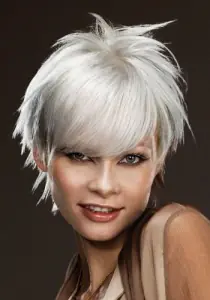
- thyroid dysfunction (autoimmune thyroiditis, hypothyroidism);
- vitiligo;
- iron deficiency anemia;
- atherosclerosis;
- Wardenburg syndrome;
- gastritis with low acidity;
- Werner's syndrome;
- Shingles.
Characteristics of gray hair
The color of the scalp for each person depends on the type of pigment:
- Eumelanin creates black or brown color;
- Pheomelanin is a red or similar shade;
- A lower concentration of pigments is typical for blondes.
Hairs lacking melanin change not only their color, but also their structure. The changes are more noticeable on dark hair than on light hair. The pigment provides elasticity and strength to the hair shaft, protects it from ultraviolet radiation and adverse environmental influences. In addition to discoloration, hair shafts become hard, split, dry, brittle and dull. They are more difficult to care for, i.e. comb and style.
Is there any point in pulling out gray hair?
Some people, in the hope of getting rid of gray hair, begin to pluck them, but this is pointless - a new, identical gray hair will grow in place of the plucked hair. Moreover, you can damage the hair follicles and develop dermatitis.
How to get rid of gray hair
It is impossible to reverse the graying mechanism, but it is quite possible to stop or slow it down. It should be noted that the problem should not be ignored by doctors and be sure to visit a therapist, endocrinologist, trichologist, who will prescribe the appropriate examination and treatment of gray hair.
How to fight gray hair and care for gray hair at home:
- Stop smoking - all heavy smokers have dull and brittle hair;
- Eat well. It is imperative that the diet includes meat, fish, vegetables and fruits;
- Be sure to get enough sleep, 8 hours a day;
- Be a physically active person. Physical inactivity is invariably associated with chronic hypoxia. And cells that do not receive enough oxygen cannot function fully, including melanocytes.
- Limit yourself from stress as much as possible. If this is not possible, take mild sedatives in traumatic situations (valerian tincture or tablets, motherwort, etc.);
- Protect the scalp and hair from temperature changes and ultraviolet radiation;
- Use high-quality cosmetic care products. Recommended products for dry, damaged hair;
- Regularly carry out self-massage of the head using special massagers or a comb with soft teeth;
- Once a week, rub a mixture of castor and burdock oil into the hair roots and leave under a warm towel for 1 hour, then rinse with shampoo;
- Instead of a rinse, you can use infusions of burdock, nettle, chamomile, and birch.
How to fight gray hair with salon treatments:
Salon treatments cannot restore natural color, but they can prevent gray hair or slow down its progression.
- Massage of the scalp. A pleasant procedure activates blood circulation, which means it improves the trophism of melanocyte cells. The procedure is carried out in beauty salons, using various nourishing oils and compositions. It is recommended to undergo 10 procedures once a quarter.
- Microelement mesotherapy, which involves intradermal injection of the scalp with microelement meso-cocktails using special syringes. The drugs are injected to a depth of 2-4 mm, allowing the delivery of useful elements to the area where the hair follicles are located. As a rule, the procedure is preceded by a spectral analysis of hair for microelements, which detects a deficiency of certain substances.
- Nourishing masks and compresses. Special formulations make it possible to restore a healthy appearance and shine to the scalp and hair, improve the structure of the hair shafts, which undergoes changes when graying, and also prepare them for coloring. Wheat germ oil, algae, natural clays, plant extracts, vitamin and microelement essences are used as components for masks (see masks for hair loss).
- Plasmolifting. For this procedure, the patient’s blood is taken, which is specially processed and purified, as a result of which plasma is released from it, without formed elements. Plasma is injected into the scalp using special syringes according to the principle of mesotherapy. It is believed that the procedure triggers the self-healing processes of skin cells, including melanocytes.
How to dye gray hair
This is perhaps the most effective way to disguise loss of hair color.
It should be noted that at least the first time you should seek help from a beauty salon specialist so that the coloring is effective. The choice of dye composition, color, exposure and frequency of dyeing is based on the following factors:
- number of gray hairs;
- hair length and structure;
- growth rate of hair shafts;
- skin type.
Sometimes before dyeing they resort to bleaching in order to achieve uniform coloring of the hair.
- With a small percentage of gray hair on the head (up to 25%), you can resort to tinting or coloring when the changed hair is dyed. The second option is highlighting or blonding, i.e. dyeing gray locks in a light color.
- When changing more than 50% of the hair, complete permanent dyeing with natural or chemical dyes is effective.
- As for the color, the darker it is, the more contrasting and noticeable the gray hair will be as the roots grow. The optimal color is golden; it does not allow gray hair to show through.
What colors really cover gray hair?
On the packaging, the manufacturer often writes “covers gray hair 100%,” but the veracity of these promises can only be verified through personal experience. Professional series of dyes or mixtures prepared by hairdressers in beauty salons, as well as special lines for gray hair from well-known brands (for example, Estelle, Matrix), are considered good. To improve the durability and strength of paint, it is recommended to add 6% professional oxidant to it.
As a rule, good and professional paints are very expensive, and you will have to use them regularly, which not everyone can afford. You can use cheap natural dyes that are safe for frequent use and easy on your wallet.
- To obtain a dark chestnut color, basma and henna are mixed in equal proportions, diluted with water to the consistency of sour cream and applied to the scalp for half an hour. The roots should be painted especially carefully. The paint is washed off with warm water.
- To obtain a soft, natural black color, mix 2 parts basma and 1 part henna, prepare the mixture according to the algorithm above.
It is easier for men to hide gray hair - just have a short haircut without focusing on problem areas of the hair. Women can use asymmetrical and multi-layered haircuts, and arrange their strands so that gray hair is hidden under normal hair.
Previously, the appearance of gray hair always occurred in adulthood and was a sign of wisdom and importance. A modern person, exposed to frequent stress and the influence of unfavorable environmental factors, may notice the appearance of gray hair at the age of 20-30. Why does gray hair appear? How to prevent its occurrence? And is this process always physiological?
Typically, the first gray hair appears at the age of 35; over time, bleached hair becomes more numerous, and after about 10 years it begins to predominate over natural-colored hair. Sometimes their appearance can occur at a younger age. Such a process may indicate the development of various pathologies and always becomes a signal of concern. Despite the fact that almost no one can prevent the appearance of gray hair, there are factors in this physiological process that can be influenced and prolong the youth and beauty of your hair. In this article we will introduce you to the causes of gray hair and methods to combat it.
Why does gray hair appear?

In order to better understand the process of gray hair formation, let's get acquainted with the physiology of hair. In humans, hair color is determined by special pigments: pheomelanin, ossimelanin, eumelanin and a group of triochromes. They are varieties of such a pigment, so familiar to everyone from school, as melanin, which is produced by special cells - melanocytes, located in the basal (lower) layer of the epidermis and in hair follicles. Melanin synthesis occurs under the influence of mediators of the sympathetic nervous system, hormones of the thyroid gland, pituitary gland (melanocyte-stimulating hormone, ACTH and β-lipotropin) and sex hormones.
Eumelanin determines dark brown or black hair color, ossimelanin - light, pheomelanin - henna shades, and the triochrome group - red shades. The mixing of these pigments in different proportions determines the hair color of each person. They color the keratin that makes up the hair shafts, and the intensity of their shade depends on how much melanin each hair follicle receives. The combination and volume of eumelanin, triochromes, ossimelanin and pheomelanin are determined genetically. This is how a wide range of hair shades appears: chestnut, black, copper, golden, red...
Melanocytes begin to work even before the birth of a child and gradually regress with age. Every 10 years after the age of 30, their function fades by 10-20%, and it is depending on the degree of their repression that gray hair appears in the head of hair - almost colorless hair with a lack of pigment in keratin. When all the melanocytes that supply melanin to the hair shaft die, all hair becomes completely gray.
Not long ago, European scientists discovered another reason for the appearance of gray hair. As it turns out, as we age, hair follicles can produce small amounts of hydrogen peroxide, which interacts with pigments and discolors them. This process can be neutralized by catalase, a special enzyme. With age, this enzyme becomes less and less, and the peroxide produced and accumulated by the follicles discolors the hair shaft from the inside. As a result, the hair becomes colorless.
Causes of gray hair
Physiological graying is associated with the natural aging of melanocytes, and the appearance of early gray hair may be due to their death or decreased activity due to hormonal disorders. As a result, the hair loses its pigment, acquires a porous structure, and the resulting air “layers” give it a silvery-white hue.
Many different factors can change your hair color. They can be divided into:
- external: unfavorable environmental conditions;
- internal: genetic characteristics, age, stressful situations, metabolic processes, etc.
The causes of gray hair can be:
- poor ecology: contributes to the development of diseases and premature aging;
- hereditary predisposition: most people experience gray hair at the same age as their parents;
- prolonged depression and chronic stress: nervous breakdowns provoke the release of large amounts of adrenaline into the blood, which breaks the connection between melanin and keratin in the hair follicles; in addition, nervous overstrain causes weakened immunity and premature aging;
- race: gray hair appears earlier in Europoids and Mongoloids, and later in Negroids;
- diseases of the thyroid gland: pathology of this endocrine organ leads to metabolic disorders;
- conditions associated with pigmentation disorders: vitiligo, albinism, tuberous sclerosis and some other diseases - gray strands can appear at any age;
- vitamin deficiencies and lack of iodine, vitamins A, group B, C, minerals copper, zinc, manganese, iron and selenium: cause pathology of internal organs and disrupt the normal blood supply to all tissues of the body;
- Poor nutrition: leads to a deficiency of vitamins and minerals that ensure the normal functioning of the entire body;
- diseases of the digestive system and kidneys lead to disruption of metabolic processes in the body;
- skin diseases: herpetic or erysipelas, alopecia areata;
- hormonal imbalance: unstable hormone levels (for example, during pregnancy, after childbirth, with polycystic ovary syndrome or during menopause) can provoke stressful situations, endocrine disorders of the thyroid gland and exhaustion of the nervous system;
- autoimmune diseases: antibodies produced in the body destroy melanocytes and lead to a lack of hair pigmentation;
- bad habits: cause many diseases, hormonal imbalance and premature aging;
- taking medications: long-term and frequent use of certain medications (especially antibiotics, Rezoquine, Chloroquine, Hydroquinone and phenylthiourea) negatively affects immunity and metabolism;
- improper care of hair and scalp: using hot water, staying in the sun or in the cold without a hat, using aggressive care, styling and coloring products have a detrimental effect on the scalp and contribute to the weakening of hair pigmentation.
Characteristics of gray hair
After losing most of the pigment, the hair shafts become ash-gray, and after losing all the melanin, they turn white. In smokers, gray hair with a yellowish tint can be observed.
In addition to bleaching, gray hair loses both its usual properties and normal structure, since melanin not only colors the hair shaft, but also protects it from external adverse factors (for example, from exposure to ultraviolet radiation) and gives it elasticity and strength. This is why, after graying, hair becomes stiffer, brittle, dry, split and unruly when styled. In some cases, they begin to tangle and curl.
How to prevent the appearance of gray hair?
Doctors and cosmetologists have not yet learned how to return gray hair to its previous shade, and the “fight” against gray hair that has already appeared can only consist of dyeing hair with special dyes with 3rd degree of durability. However, it is possible to prevent early graying, get rid of single gray hairs and stop the progression of this process if you follow a number of simple rules.
Nutrition
Balancing our diet is one of the key factors that contribute to maintaining youth, health and beauty. To prevent graying, you should include foods rich in these six minerals in your diet:
- calcium – dairy products, soy, nuts, wheat, greens;
- copper – eggs, beans, green vegetables, almonds, mushrooms, pumpkin seeds;
- zinc – mushrooms, whole grains, oysters, egg yolks;
- chromium – oysters, wine, wheat bread;
- iron – seaweed, apples, legumes, buckwheat, beef, eggs, cocoa;
- iodine – black currant, sea fish, persimmon, seaweed.
For normal hair pigmentation, your daily diet should include foods high in the following vitamins:
- beta carotene – carrots, cabbage, fish, spinach, liver;
- E – almonds, peanuts, hazelnuts, sea buckthorn, dried apricots, pistachios, wheat, spinach, viburnum;
- WITH – citrus fruits, rose hips, kiwi, apples, berries, bell peppers, wild garlic, Brussels sprouts;
- group B (B3, B5, B6, B7, B10 and B12) – pine nuts, cashews, lentils, pork, rabbit, mackerel, sardines, liver, champignons, eggs, dairy products, beans, walnuts, sea buckthorn;
- folic acid – liver, peanuts, walnuts, beans, spinach, hazelnuts, broccoli, wild garlic;
- inositol – melon, nuts, meat, prunes, kiwi, legumes.
The above minerals and vitamins are important not only for normal hair pigmentation, but are also necessary for maintaining hair health. Daily inclusion of foods rich in them in your diet will improve your hair and make it shiny and strong.
In addition to these vitamins and minerals, your diet should include foods high in Omega-3 and Omega-6 fatty acids:
- flax seeds;
- fish fat;
- salmon;
- olive oil;
- oats;
- almonds, etc.
All these beneficial substances can be taken in the form of dietary supplements and vitamin-mineral complexes:
- Melan+ for men and Melan+ for women;
- Neurobex;
- Complements selenium.
They should be taken with meals and with plenty of water. These medications should not be taken after heavy meals, as in such cases they will not be fully absorbed.
Drinking regime
Hair follicles are extremely sensitive to lack of fluid in the body. Lack of water impedes the intake and absorption of nutrients and can cause graying of hair. That is why, to maintain their health, it is necessary to drink 1.5-2 liters of water daily.
Proper hair care
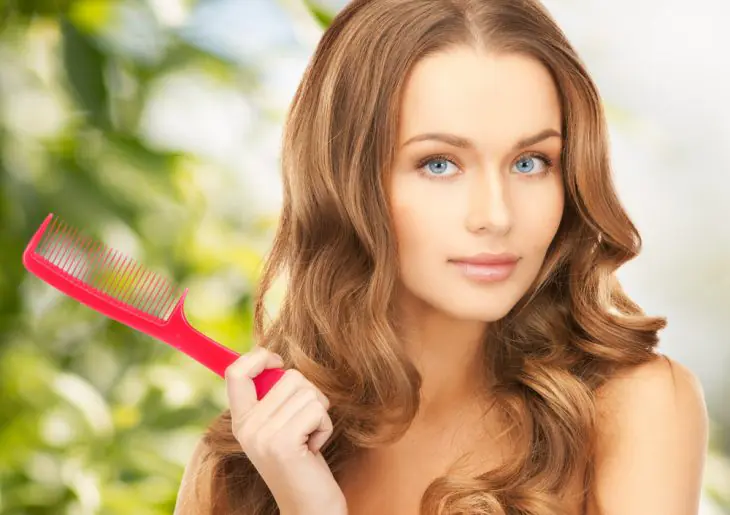
When the first gray hair appears, you should pay close attention to hair care:
- Wash your hair with water at a comfortable temperature.
- Use shampoos, conditioners and masks that contain non-aggressive detergent ingredients, vitamins, natural extracts and nutrients.
- Minimize the use of hair dryers, curling irons, straighteners, aggressive dyes and styling products.
- Wear hats in hot and frosty weather.
- Avoid styling that disrupts normal blood circulation in the scalp: ponytails, braids, the use of hairpins, elastic bands, etc.
Salon treatments
The appearance of gray hair can be stopped using the following procedures performed in beauty salons:
- laser therapy;
- plasma lifting;
- ultrasound therapy;
- microelementary mesotherapy.
Hardware hair treatment methods can be supplemented by the use of nourishing masks and vitamin serums:
- Dikson POLIPANT COMPLEX;
- Dercos Technique Vichy;
- Intensive Energizing Complex, etc.
Folk remedies
To prevent the appearance of gray hair, you can use various folk remedies that help restore their health.
Garlic mask
Pass the garlic through a press. Add a little burdock oil to the resulting paste and rub into the hair roots with gentle massaging movements. The head should be wrapped in a warm towel. Rinse off the mask after 10-15 minutes, rinse hair with shampoo. Repeat the procedure 2 times a week.
Applications with infusion of burdock roots
Pour 2 tablespoons of chopped burdock roots and 2 teaspoons of dill fruit into 0.5 liters of boiling water and leave for about 3 hours. Rub into clean scalp 2 times during the day. The procedure should be repeated daily for 3 months.
Wheat germ oil mask
Mix 30 ml of wheat germ oil with 7 drops of lavender, rose and sandalwood oil. Apply with massaging movements to the scalp, wrap and keep for about 1-2 hours. Wash off with shampoo. The mask should be applied 2 times a week for 2-3 months.
Before using these and other folk remedies, you should make sure that there is no allergic reaction to the components of the recipe.
Stress management
Normal functioning of the body is possible only in the absence of stress. The mechanism of action of numerous neurotransmitters on the body and hair pigmentation, which enter the bloodstream during stressful situations, helped to understand the discovery made by 2012 Nobel Prize winner chemist Robert Lefkowitz. It is long-term exposure to stress factors that can cause graying and many other negative consequences.
To avoid physical and psycho-emotional stress, it is recommended to get rid of all provoking factors and bad habits, master relaxation techniques, normalize sleep and rest patterns, spend more time in the fresh air, engage in physical exercise, hobbies and lead a healthy lifestyle. If necessary, you should undergo treatment from a neurologist or psychotherapist.
Treatment of chronic diseases
Regular follow-up with a specialist and following all his recommendations will help prevent the appearance of gray hair in various chronic diseases - autoimmune pathologies, diseases of the skin, thyroid gland, digestive tract, kidneys.
Which doctor should I contact?
When the first bleached hair appears, you should contact a trichologist, who can conduct a detailed examination (spectral analysis of hair for the presence of microelements, blood tests for the level of thyroid hormones and vitamin levels, etc.) and draw up a plan for further treatment and prevention of graying. If you have early gray hair, you may need to consult an endocrinologist, nephrologist or gastroenterologist.
Video version of the article
Useful video about gray hair: the program “About the Most Important Thing”
Gray hair appears in most people who have crossed a certain age limit. People most often notice their first gray hair at the age of 30-35 years, and then their number gradually increases over time.
However, premature graying is a common problem for many men and women who do not want to look older than their years, but suddenly find themselves with individual white hairs or even entire strands. A similar nuisance can happen both to those who often visit doctors and to absolutely healthy people.
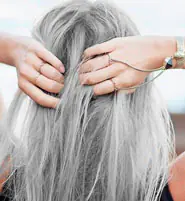
Why do some people go gray and start dyeing their hair at 20, while others don’t have any worries until they are 50? If gray hair appears early, is there anything that can be done?
From the day a person discovers a few gray hairs, it can take more than 10 years before gray hair becomes predominant. Therefore, you can try to stop or at least slow down this process.
But first, it’s worth understanding how gray hair differs from “young” hair and where it comes from.
What is gray hair?
Eumelanin and pheomelanin
Melanocytes produce eumelanin, which is responsible for the black or dark brown color, and pheomelanin, which determines the reddish-yellow color.
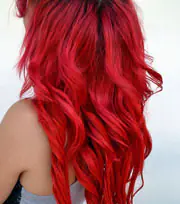
In a certain proportion, these pigments color keratin, the main protein that makes up hair. Dark or light hair color depends on how much melanin each hair follicle receives. In turn, the volume and combination of different types of melanin are mainly determined by our genes. Thus, we get the widest range of natural shades: golden, light brown, reddish, chestnut, black.
Melanocytes begin to work before we are born, and their function gradually regresses over the years. Typically, their activity decreases by 10-20% every 10 years after age 30. As graying progresses, the melanocytes die off until they disappear completely, and then all the hair grows colorless, that is, gray.
Hydrogen peroxide
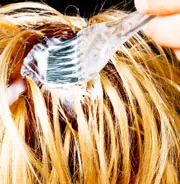
In 2009, scientists in Europe discovered another factor that causes hair to discolor with age. They found that hair follicles produce some amount of hydrogen peroxide. As any teenager knows, this substance is widely used to artificially whiten hair.
This substance is usually broken down by the enzyme catalase. But as a person ages, catalase production becomes less efficient. As a result, hydrogen peroxide accumulates, and it turns out that it whitens the hair from the inside, as if the owner had dyed it with bleaching dye.
Why does gray hair appear? (7 reasons)

There are many factors that can change hair pigmentation. Scientists divide them into internal (genetic characteristics, hormones, metabolism, age) and external (ecology, various adverse effects).

Very often, heredity is a predisposing factor. This means that most people will start to experience gray hair around the same age as their parents and grandparents. By the way, statistics show that representatives of different races turn gray at different times. The fastest are Caucasoids, then Mongoloids, and last of all are Negroids. It is noteworthy that those with red hair, on average, acquire gray hair earlier than anyone else.

Stress and psychological problems can also cause early graying of hair. According to research, people who suffer from anxiety and stress for a long period of time can expect gray hair to appear early. Depression and sadness can have a detrimental effect on health in general and reduce melanin production in particular.

It is noted that the early appearance of gray hair is more common in people who suffer from chronic sinusitis and colds.

Using hot water to wash your hair can disrupt the mechanism of pigment formation and cause graying.

Smoking also affects the age at which gray hair appears. The harmful substances that a smoker receives reduce the level of oxygen in the blood and the cells “starve”, including melanocytes.

Problems with the thyroid gland can cause hair discoloration.

A diet lacking vitamins can cause premature graying. The lack of certain vitamins, iron, copper, iodine in the daily diet is considered a significant factor.
How to eat to avoid going gray?

Lifestyle and diet are key factors in maintaining health and youth, but most of us buy food without thinking about its usefulness or making an attempt to maintain the right balance of vitamins and minerals.
Meanwhile, any product contains a certain set of substances, each of which performs its own function and its deficiency can cause certain disorders. Including hair loss and bleaching.
6 Minerals That Help Prevent Early Gray Hair
- Calcium. Milk and any dairy products are a good source of calcium.
- Chromium. Wheat bread, wine, and oysters are sources of chromium.
- Copper. Green vegetables, eggs, chicken, mushrooms and beans, almonds and pumpkin seeds contain large amounts of copper.
- Iodine. If you have problems with the thyroid gland, products containing iodine will help with hair loss and premature graying of hair. These are garlic, persimmon, black currant, sea fish.
- Zinc. Mushrooms, oysters, whole grains and egg yolks are the main sources of zinc.
- Iron. Beef, buckwheat, eggs, apples, seaweed, legumes and cocoa will help avoid iron deficiency in the body.
Groups of vitamins vital for hair
- Beta carotene Known as an antioxidant, it helps the scalp stay healthy and also ensures proper sebum production. Vegetables, carrots, cabbage, spinach, fish, liver are the main sources of it.
- Vitamins C, E and B vitamins (B3, B5, B6, B7, B12) promote active blood circulation in the scalp.
- Vitamin Inositol considered very important for hair follicles. It is found in the highest concentrations in prunes, melon, and kiwi. It is present in some quantities in seeds (legumes, cereals, nuts), as well as milk and meat.
These substances are critical for preventing premature graying, as well as maintaining healthy hair. If you lead a healthy lifestyle and include enough vitamins and minerals in your diet every day, your hair will be healthy and shiny.

What to do to avoid going gray?
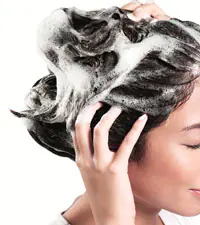
In addition to age-related skin changes and other annoying but inevitable side effects of the wisdom that comes with age, we are also faced with graying hair. But there are anti-aging serums for the skin, as well as surgical and non-surgical methods that can quite effectively counteract the effects of aging. What about hair?
Today, the most common way to “fight” gray hair is to dye all hair with a special dye. Unfortunately, we have to admit that this method is still the most effective: doctors and cosmetologists have not yet learned how to return the color to gray hair.
However, there are several principles, the observance of which helps to postpone gray hair until later years, and in some cases, to get rid of prematurely appearing single gray hairs.
Drinking enough fluids
Hair follicles need fluid to function properly. Lack of moisture and hydration prevents nutrients from reaching the hair follicles and thus can trigger the appearance of gray hair.
Neglect of thirst, addiction to alcohol and coffee abuse increase the likelihood of going gray prematurely.
Proper nutrition
The substances listed above will help maintain youthful and healthy hair for as long as possible. It is especially important to include foods with vitamin B12, folic acid and Omega-3 in your diet. These three ingredients are most effective in combating gray hair when taken as vitamin supplements or in foods.
Improved blood circulation
Blood circulation and blood supply are vital to preventing gray hair. There's little point in eating vitamins and minerals if they can't reach your hair follicles.
Physical activity will be helpful to improve blood circulation. For the lazy and busy, massage your scalp with your fingertips. If you spend 5-10 minutes a day on it, microcirculation will improve significantly and your hair may “change its mind” about turning gray and falling out.
Stress management
Stress is not the only cause of gray hair, but it is one of them. In 2012, Nobel Prize winner in chemistry Robert Lefkowitz discovered a mechanism that may explain why stress causes gray hair.
An extreme situation causes the release of numerous neurotransmitter substances designed to mobilize all the body's reserve resources. Usually their effect is short-lived and really helps to cope with the threat. Long-term exposure to these substances on the body, however, can cause graying and a host of other negative effects.
To give up smoking
It has been scientifically proven that smoking causes premature aging of the body and poor circulation. Giving up it is the first step of any person who wants to prolong his youth.
In addition to active rest and diet, it is important to take care of adequate, sufficiently long sleep.



